The COPS Housing Developments
In 1937, New Orleans became the first city in the United States to
benefit under the Wagner Act for the eradication of "slums"
by providing housing for low income families.
Act No. 275, known as the Housing Act saw the creation of a Housing Authority
in every city in Louisiana with a population over 20,000 to oversee the
housing "projects".
The "projects" were originally envisioned as replacement housing
for "negroes" living in "slums". To quote some quotables
of the day-
"These projects were part and parcel of the relief program born of
the depression to assist families who had become, to some extent at least,
potential charges on the state for adequate housing, due to the lack of
their sufficient income."
"(the) projects were organized not for profit, but for the sole
benefit of the underprivileged who, theretofore lived in sections
of New Orleans known as slums."
Occupants living on the sites chosen for construction of the first
projects, the Magnolia, later known as the C.J. Peete, and the St. Thomas,
generally found themselves being moved from their homes whether they liked
it or not. Owners who held out for higher prices on their properties at
the construction sites tended to find their properties summarily condemned
and their values significantly lower than when they had started.
At the time of first occupancy, in 1941, rentals for the housing projects,
based on income, were from $8.25 a month for a one bedroom apartment to
$22.00 a month for a three bedroom. The highest income acceptable for admission
was $1325.00 a year unless the applicants had three or more dependents in
which case the maximum was $1475.00.
Although the official reports of the Housing Authority from 1937 to1964
are unremarkable, except for the hundreds of pictures of project residents
enjoying basket weaving, homemaking and other crafts classes, there are
some amusing items.
For instance, on January 1,1949, after a period of investigation, the Housing
Authority of New Orleans decided to permit television sets with the following
restrictions:
- No antennae were allowed on the roof.
- No alterations from installation were allowed in the apartments and,
- All installations were subject to the safety regulations of the fire
department.
The residents of the projects were not immune to the throes of McCarthyism
in the '50's. All tenants and applicants were required to sign a form indicating
they belonged to no subversive groups.
Poor construction and vandalism were a constant topic in the Housing Authority's
annual reports and the developments today are in a poor state. Their future
is uncertain.
Desire
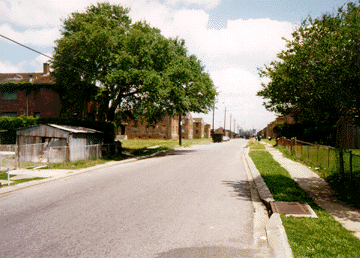 Completed in 1954, the Desire Housing Development originally consisted of
262 two story, wood & brick veneer buildings on a 97.2 acre site.
There were 1860 original units.
Completed in 1954, the Desire Housing Development originally consisted of
262 two story, wood & brick veneer buildings on a 97.2 acre site.
There were 1860 original units. 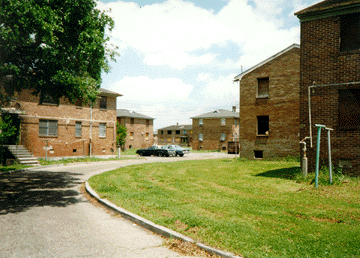 Five hundred and eight were built by Pittman Construction Co. and 1352 by R.F. Ball of San Antonio. The cost of construction in 1954 dollars was $23,686,436.
Five hundred and eight were built by Pittman Construction Co. and 1352 by R.F. Ball of San Antonio. The cost of construction in 1954 dollars was $23,686,436.
Five of the original buildings were demolished after being damaged by Hurricane
Betsy in 1965. At one time there were also two schools on the site; Dunn,
an elementary school, and Moton. Both of these schools have since been demolished
as well. The Desire is the only development not constructed of solid masonry
on concrete slabs.
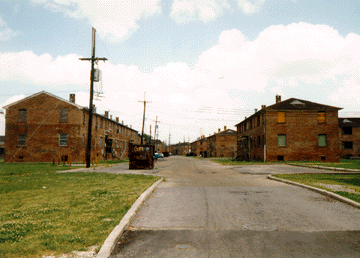 The original population, with first occupancy in 1956, was 9485. By
1958 this had grown to 13,540 and 20 years later the population was still
over 10,000. The 1980 census reported 8575 occupants and the 1990 census
counted a population of 4164. The most recent records say there are 2175
occupants.
The original population, with first occupancy in 1956, was 9485. By
1958 this had grown to 13,540 and 20 years later the population was still
over 10,000. The 1980 census reported 8575 occupants and the 1990 census
counted a population of 4164. The most recent records say there are 2175
occupants.
Plans, already initiated, call for demolition of 40% of the development
with creation of homeownership opportunities.
Florida
 The first phase of the Florida development was constructed between
1941 and 1946, consisting of 47 two and three story buildings, totaling
500 units on an 18.5 acre site. In 1953 an additional 234 units in 67 buildings
on a 7.6 acre site were built. Presently there are 67 buildings, with 734
units, occupying 26.1 acres.
The first phase of the Florida development was constructed between
1941 and 1946, consisting of 47 two and three story buildings, totaling
500 units on an 18.5 acre site. In 1953 an additional 234 units in 67 buildings
on a 7.6 acre site were built. Presently there are 67 buildings, with 734
units, occupying 26.1 acres.
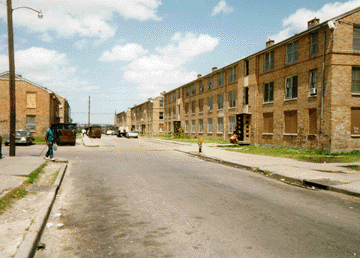 Originally slated for white occupancy, the Florida development fell under
the provisions of the Lanham Act for accommodation of workers in essential
war industries. After the war, occupancy restrictions were changed to permit
use for veterans, servicemen and their families.
Originally slated for white occupancy, the Florida development fell under
the provisions of the Lanham Act for accommodation of workers in essential
war industries. After the war, occupancy restrictions were changed to permit
use for veterans, servicemen and their families.
Plans call for demolition of 45% of the development and homeownership opportunities
to be created. Those plans are currently on hold.
C.J. Peete
 The C.J. Peete Housing Development, originally the Magnolia Project, built
by the R.P. Farnsworth Co. of New Orleans, saw first phase construction
between 1939 and 1941 on 23.75 acres with 723 units built.
The C.J. Peete Housing Development, originally the Magnolia Project, built
by the R.P. Farnsworth Co. of New Orleans, saw first phase construction
between 1939 and 1941 on 23.75 acres with 723 units built. 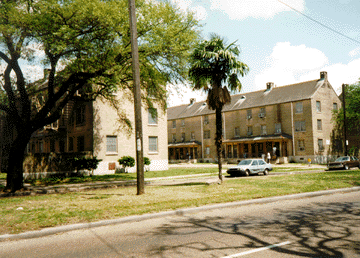 Phase two was
constructed between1953 and 1956 on 17.7 acres with 680 units built. Today
there are 1403 units. Occupancy between 1980 and 1990 remained fairly steady,
contrary to the other developments, and has grown somewhat.
Phase two was
constructed between1953 and 1956 on 17.7 acres with 680 units built. Today
there are 1403 units. Occupancy between 1980 and 1990 remained fairly steady,
contrary to the other developments, and has grown somewhat.
B.W. Cooper
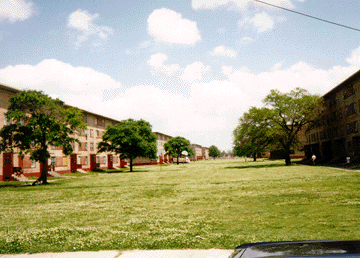 Construction on the B.W. Cooper development, formerly the Calliope Project,
by the George A. Fuller Co. of Washington D.C., began in 1939 and was completed
in 1941.
Construction on the B.W. Cooper development, formerly the Calliope Project,
by the George A. Fuller Co. of Washington D.C., began in 1939 and was completed
in 1941. 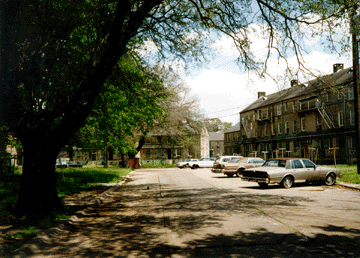 The second phase was awarded to R.P. Farnsworth, Inc on March
19, 1952. The B.W. Cooper consists of 1550 units on 56 acres. As of December of 1994 occupation was 3623.
The second phase was awarded to R.P. Farnsworth, Inc on March
19, 1952. The B.W. Cooper consists of 1550 units on 56 acres. As of December of 1994 occupation was 3623.
 Completed in 1954, the Desire Housing Development originally consisted of
262 two story, wood & brick veneer buildings on a 97.2 acre site.
There were 1860 original units.
Completed in 1954, the Desire Housing Development originally consisted of
262 two story, wood & brick veneer buildings on a 97.2 acre site.
There were 1860 original units.  Five hundred and eight were built by Pittman Construction Co. and 1352 by R.F. Ball of San Antonio. The cost of construction in 1954 dollars was $23,686,436.
Five hundred and eight were built by Pittman Construction Co. and 1352 by R.F. Ball of San Antonio. The cost of construction in 1954 dollars was $23,686,436. 





